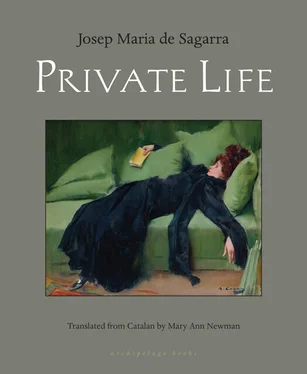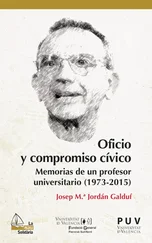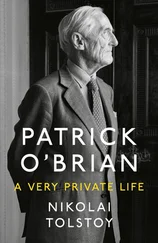Josep Maria de Sagarra - Private Life
Здесь есть возможность читать онлайн «Josep Maria de Sagarra - Private Life» весь текст электронной книги совершенно бесплатно (целиком полную версию без сокращений). В некоторых случаях можно слушать аудио, скачать через торрент в формате fb2 и присутствует краткое содержание. Год выпуска: 2015, ISBN: 2015, Издательство: Archipelago, Жанр: Современная проза, на английском языке. Описание произведения, (предисловие) а так же отзывы посетителей доступны на портале библиотеки ЛибКат.
- Название:Private Life
- Автор:
- Издательство:Archipelago
- Жанр:
- Год:2015
- ISBN:978-0-914671-27-5
- Рейтинг книги:3 / 5. Голосов: 1
-
Избранное:Добавить в избранное
- Отзывы:
-
Ваша оценка:
- 60
- 1
- 2
- 3
- 4
- 5
Private Life: краткое содержание, описание и аннотация
Предлагаем к чтению аннотацию, описание, краткое содержание или предисловие (зависит от того, что написал сам автор книги «Private Life»). Если вы не нашли необходимую информацию о книге — напишите в комментариях, мы постараемся отыскать её.
for its contemporaries, was a scandal in 1932. The 1960's edition was bowdlerized by Franco's censors. Part Lampedusa, part Genet, this translation will bring an essential piece of 20th-century European literature to the English-speaking public.
Private Life — читать онлайн бесплатно полную книгу (весь текст) целиком
Ниже представлен текст книги, разбитый по страницам. Система сохранения места последней прочитанной страницы, позволяет с удобством читать онлайн бесплатно книгу «Private Life», без необходимости каждый раз заново искать на чём Вы остановились. Поставьте закладку, и сможете в любой момент перейти на страницу, на которой закончили чтение.
Интервал:
Закладка:
Pilar had a democratic mentality and, without her realizing it, her heart took part in the air of rebirth that was becoming more and more accentuated in Barcelona.
When she married Xuclà the banker, her personality became more refined; bit by bit, it was honed. In her, a traditional and popular Barcelonism was united with natural elegance and perfect beauty. Pilar was the least affected, most natural lady one could ever hope to meet. The somber timidity of the black armoires, the doleful chiffarobes, the lady’s bustles, the lack of hygiene, and the cone-shaped cucurulles worn by penitents in Holy Week processions could be summed up, in a word, as the provincialism that would convert the Catalan aristocracy of the turn of the century into a sort of shabby and reactionary extension of restoration Madrid. Against all this Pilar offered up, unabashed, a seamstress’s little snub nose and the kind of laughter you might hear among the carts of the greengrocers and the red breeches in the soldiers’ garrisons.
Once they were married, a state of polite coolness did not take long in manifesting itself in the marriage. Xuclà the banker was quite satisfied with his wife, because she was intelligent, she was decorative, and she was the most dazzling person in Barcelona. But Xuclà the banker had other kinds of tastes, and his polygamous temperament led him on the chase for fresh quarry. Pilar surrounded herself with a motley circle and showed utter scorn for her parent’s circle of relations. Out of obligation, she would take up her position in the front seats at the grand parades, and her place there was never in question. Yet her sense of humor and her offhanded way of speaking scandalized certain segments of the circle of the Comtes de Sallent, and word began to get around that Pilar had a wandering eye. Another segment of the aristocratic sphere maintained, through thick and thin, that Pilar’s behavior was beyond reproach. This was the plaintive segment that wept for “poor Pilar” and accused her husband of being perfectly vile.
As always, there was truth and untruth on both sides of the question. Among her detractors, some crusty and unbearable marquesa would claim that Pilar Xuclà was worse than a cocotte , that a dozen lovers were too few for her and that her husband was within his sacred right to seek distraction elsewhere. This was a great exaggeration. Pilar didn’t share the compunctions of the other grandes dames. She had had actresses over to her house on Carrer Ample, and in particular she had been quite friendly with a ballerina who had danced for two seasons at the Liceu and was famous for being brazen and for having blackmailed a prince from the house of Orleans. The day this dancer performed before a select audience at one of Pilar’s salons, a panic not dissimilar to a run on the stock market rippled through many Barcelona families. The scandal was sublime. There are those who remember it even today. So as not to have to break off relations with their daughter once and for all, the Comtes de Sallent pretended not to have heard a word about it. To avoid comment they spent four months away from Barcelona.
Pilar stood her ground. Three of the most prominent ladies of the day assembled to discuss whether they should continue receiving her in their homes. It is said that this conference — according to people who remember this, as well — broke all records in terms of feminine ferocity. The attempt by the three ladies was a fiasco. Pilar was too pretty and too brilliant. And her husband had too much money and was too enmeshed in the interests of many of her detractors. All la Senyora Xuclà had to do was don a floor-length ermine coat to distract the ladies’ tongues away from the pecadilloes of the lady who wore it.
Of all the improprieties attributed to Pilar, the only one that might have had some substance involved Sebastià Ripoll, the artist. This painter, a friend and disciple of Martí Alsina, died a miserable death in Paris in the days when artists of means like Ramon Casas and Santiago Rusiñol were striking out to discover Montmarte. In Pilar’s youth, though, he had possessed the most exciting black beard in Barcelona. Sebastià Ripoll was no bohemian, but the son of a manufacturer, and a friend to opulent chorus girls and idle fellows with artistic leanings. He had a place at certain privileged tables and a chair in the penyes of the men’s clubs, bull sessions at which the topics of the day were discussed.
Sebastià Ripoll was an easygoing and agreeable painter, of a piece with the bourgeois tastes of the moment. He painted Pierrots , indigents and odalisques. He also painted portraits by commission, in which he dissolved flesh into caramel and redingotes into squid’s ink, applying a theatrical grace between the lips and the eyes that even today is not entirely obnoxious on one wall or another.
Aside from his paintbrushes and his juvenile erotic vanity, Sebastià Ripoll was a delicate bon vivant. Pilar selected him from among all her friends to be the artistic dictator of her home. The banker gave him cigars worthy of breaking out on the high holidays, and Ripoll the painter declared that the most velvety coffee of Barcelona could be had on Carrer Ample, where there was a lady who could be tenderly spiritual, with manners redolent of pepper and cinnamon, while not looking down on authentic homegrown garlic.
Pilar and Sebastià Ripoll enacted a novella in which it cannot be asserted that bedrooms, quilts and physiology played an exclusive role. The banker was unperturbed by the novella. A broadminded independence reigned in their marriage and he continued to treat the painter with generous liberality. And when he went abroad, he didn’t lose a moment’s sleep knowing that as his best friends sipped on an orxata or sniffed a carnation, they would be categorically affirming that his wife was cuckolding him.
As Xuclà the banker had inherited from his ancestors a good Hebrew complexion, regarding virile honor he had very clear and intelligent ideas. Pilar agreed with her husband’s ideas, but she made sure not to abuse them. Not out of any respect for the capricious kid-gloved satyr she was married to, but because Pilar, a good daughter of the nineteenth century, still believed that a lady with any self-respect didn’t go around losing her corset in any old corner, like a butcher woman coming down from an Ash Wednesday tryst on Montjuïc.
A portrait by Ripoll the painter of the Pilar of those days has been preserved in the home of D., the collector. Even if you observe the canvas with a hint of skepticism, abstracting the element of personal passion on the part of the black-bearded man, you cannot help but take in all the perfume of an extinct Barcelona that touches the heart of those who appreciate such things. In the painting, Pilar is standing with the smiling immobility of a Juno. Her neckline reveals bare arms and a rather generous triangle of flesh under her neck. Her skirt, made of mulberry satin, has a very long ruffled train and clings gently to her hips and thighs. She is wearing gloves the color of polished white bone that reach to above her elbow, and she holds a silk mask between two fingers of her right hand. A set of silver dominoes and a great bouquet of camellias bursting from a striped paper cone rest upon a strategically-placed sofa.
Ripoll’s ambition had sucked so deeply into her face that blood would have surged to the most academic lips. Her nose, chiseled slightly upward, seems still to be breathing in the sweat and fragrances of a masked ball. Her eyes reveal nothing but the great discretion hidden in her irises, green as the impenetrable gray green of the flounder’s slimy skin. And her hair, part gold, part ash, has something of a storm and something of the moss on a stone, a sort of geological romanticism reminiscent of the verses of Verdaguer’s Atlantis .
Читать дальшеИнтервал:
Закладка:
Похожие книги на «Private Life»
Представляем Вашему вниманию похожие книги на «Private Life» списком для выбора. Мы отобрали схожую по названию и смыслу литературу в надежде предоставить читателям больше вариантов отыскать новые, интересные, ещё непрочитанные произведения.
Обсуждение, отзывы о книге «Private Life» и просто собственные мнения читателей. Оставьте ваши комментарии, напишите, что Вы думаете о произведении, его смысле или главных героях. Укажите что конкретно понравилось, а что нет, и почему Вы так считаете.












